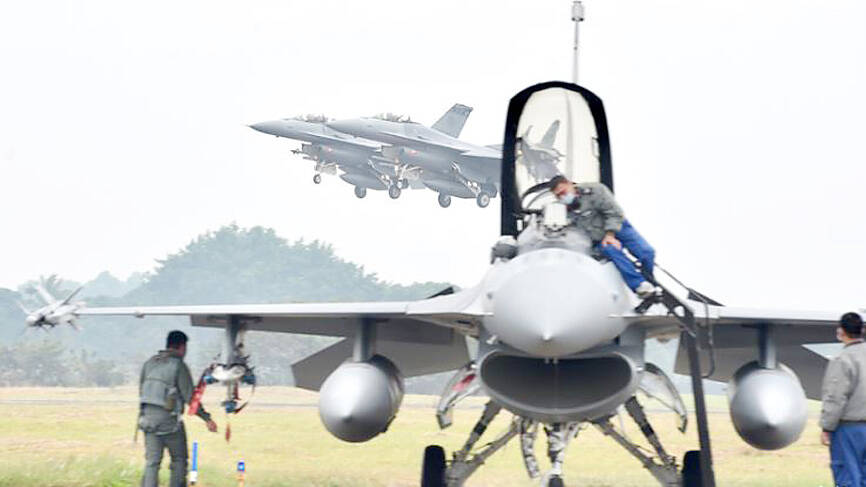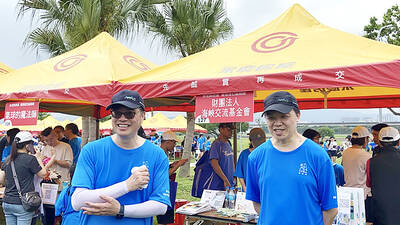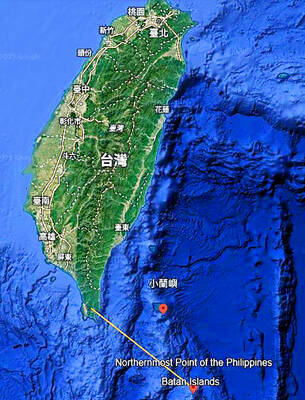The Ministry of National Defense (MND) has signed two deals worth NT$12.84 billion (US$419.31 million) with the US for parts and aviation materials to maintain Taiwan’s fighter jet fleet.
The ministry signed the agreements with the American Institute in Taiwan — NT$9.9 billion for spare parts and NT$2.94 billion for nonstandard parts and aviation materials — it said in a public contract notice on Friday.
The spare parts contract is to be implemented from this month to March 2028, while the smaller agreement also starts from this month through June 2027, it said.

Photo: Taipei Times file photo
The air force is under immense strain to maintain jets as it is flying numerous missions in response to China’s constant military incursions into the nation’s air defense identification zone (ADIZ), a defense official said on condition of anonymity.
Fighters have been scrambled to shadow Chinese jets and large uncrewed aerial vehicles, while also conducting other missions, including reconnaissance flights by RF-16s, they said.
The missions haven taken a heavy toll on Taiwanese aircraft and led to a significant increase in demand for parts and materials, they said, adding that the navy has also been obliged to deploy warships to monitor Chinese military vessels.
The military has already exhausted its budget for jet and ship fuel because of attempts to counter Beijing’s activities, the official said, adding that the Executive Yuan released NT$1.68 billion from its reserve funds for fuel.
The military from early Thursday to early yesterday detected 19 aircraft sorties, including 10 that crossed the median line of the Taiwan Strait or entered the country’s southwestern ADIZ, in addition to five naval sorties in waters around Taiwan, the ministry said.
In other news, members of the legislature’s Foreign Affairs and National Defense Committee are on Thursday to tour a facility of CSBC Corp, Taiwan (台灣國際造船), the company contracted to build a prototype of an indigenous submarine.
The visit was listed in the legislators’ public schedules, although the purpose of the tour was classified.
The prototype submarine utilizes a partial double-hull design consisting of six pressurized compartments and a conning tower, with an X-shaped tail rudder and stabilizing fins on the sides of the tower, CBSC said.
The 70m-long submarine is to carry 18 MK-48 torpedoes and an undisclosed number of ship-launched Harpoon missiles. It is to have a displacement of 2,500 to 3,000 tonnes.
CSBC is in the process of completing the submarine’s pressure hull and said it expects to launch the vessel in September.
Last month, the defense ministry invited professors and students of engineering to attend a presentation on the making of the prototype and tour CSBC’s submarine factory in Keelung’s Jhongjheng District (中正).
CSBC used computer models to simulate the submarine’s assembly and a mock-up of the vessel has been built to train maintenance personnel, an attendee of the tour said in an article published anonymously on the Chinese-language online news outlet Up Media.
The factory at that time was working on the bow torpedo tubes, which is the most critical step in manufacturing the pressure hull, the person said.
The use of a large five-axis computer numerical control machine showed that crews were paying careful attention to reducing the vessel’s weight, they added.

SECURITY: As China is ‘reshaping’ Hong Kong’s population, Taiwan must raise the eligibility threshold for applications from Hong Kongers, Chiu Chui-cheng said When Hong Kong and Macau citizens apply for residency in Taiwan, it would be under a new category that includes a “national security observation period,” Mainland Affairs Council (MAC) Minister Chiu Chui-cheng (邱垂正) said yesterday. President William Lai (賴清德) on March 13 announced 17 strategies to counter China’s aggression toward Taiwan, including incorporating national security considerations into the review process for residency applications from Hong Kong and Macau citizens. The situation in Hong Kong is constantly changing, Chiu said to media yesterday on the sidelines of the Taipei Technology Run hosted by the Taipei Neihu Technology Park Development Association. With

A US Marine Corps regiment equipped with Naval Strike Missiles (NSM) is set to participate in the upcoming Balikatan 25 exercise in the Luzon Strait, marking the system’s first-ever deployment in the Philippines. US and Philippine officials have separately confirmed that the Navy Marine Expeditionary Ship Interdiction System (NMESIS) — the mobile launch platform for the Naval Strike Missile — would take part in the joint exercise. The missiles are being deployed to “a strategic first island chain chokepoint” in the waters between Taiwan proper and the Philippines, US-based Naval News reported. “The Luzon Strait and Bashi Channel represent a critical access

‘FORM OF PROTEST’: The German Institute Taipei said it was ‘shocked’ to see Nazi symbolism used in connection with political aims as it condemned the incident Sung Chien-liang (宋建樑), who led efforts to recall Democratic Progressive Party (DPP) Legislator Lee Kun-cheng (李坤城), was released on bail of NT$80,000 yesterday amid an outcry over a Nazi armband he wore to questioning the night before. Sung arrived at the New Taipei City District Prosecutors’ Office for questioning in a recall petition forgery case on Tuesday night wearing a red armband bearing a swastika, carrying a copy of Adolf Hitler’s Mein Kampf and giving a Nazi salute. Sung left the building at 1:15am without the armband and apparently covering the book with a coat. This is a serious international scandal and Chinese

COUNTERINTELLIGENCE TRAINING: The ministry said 87.5 percent of the apprehended Chinese agents were reported by service members they tried to lure into becoming spies Taiwanese organized crime, illegal money lenders, temples and civic groups are complicit in Beijing’s infiltration of the armed forces, the Ministry of National Defense (MND) said in a report yesterday. Retired service members who had been turned to Beijing’s cause mainly relied on those channels to infiltrate the Taiwanese military, according to the report to be submitted to lawmakers ahead of tomorrow’s hearing on Chinese espionage in the military. Chinese intelligence typically used blackmail, Internet-based communications, bribery or debts to loan sharks to leverage active service personnel to do its bidding, it said. China’s main goals are to collect intelligence, and develop a